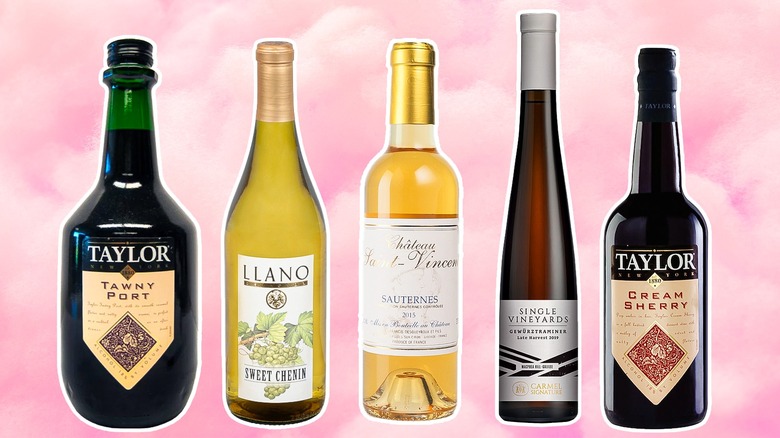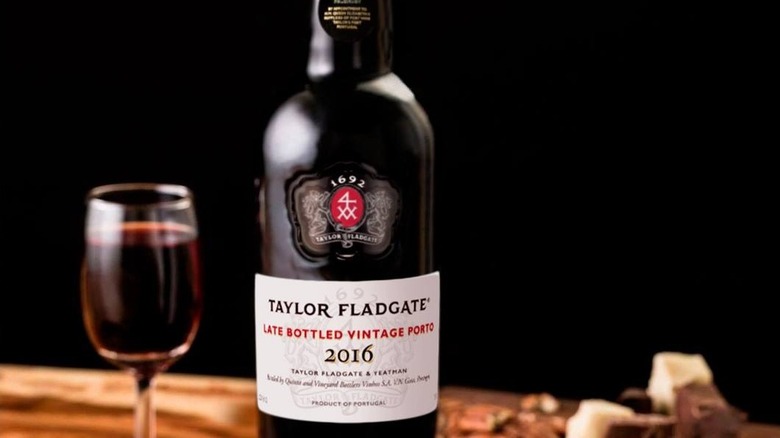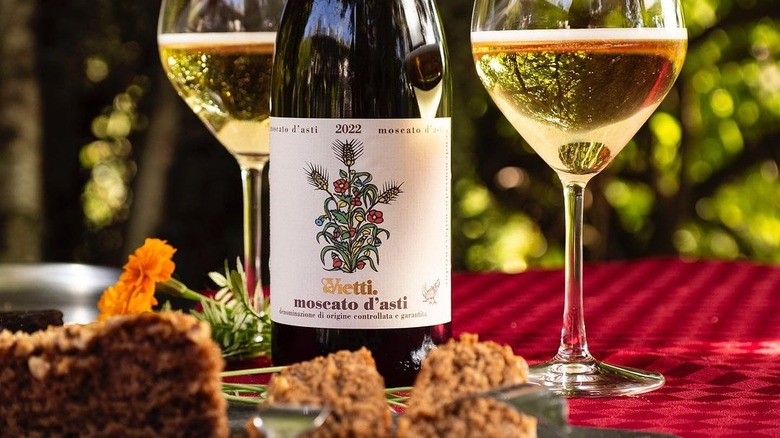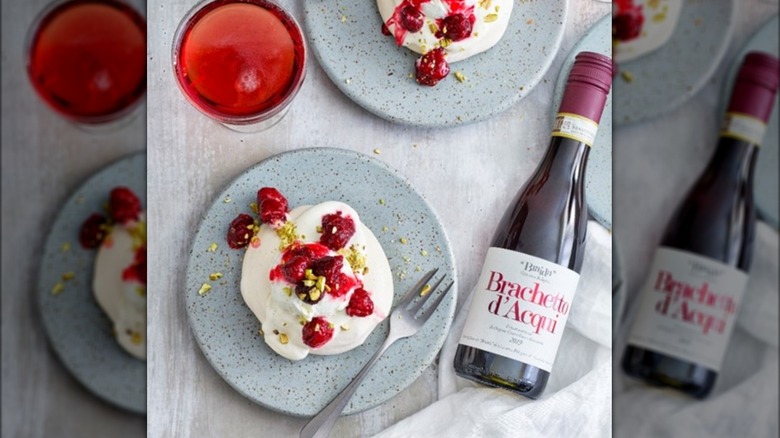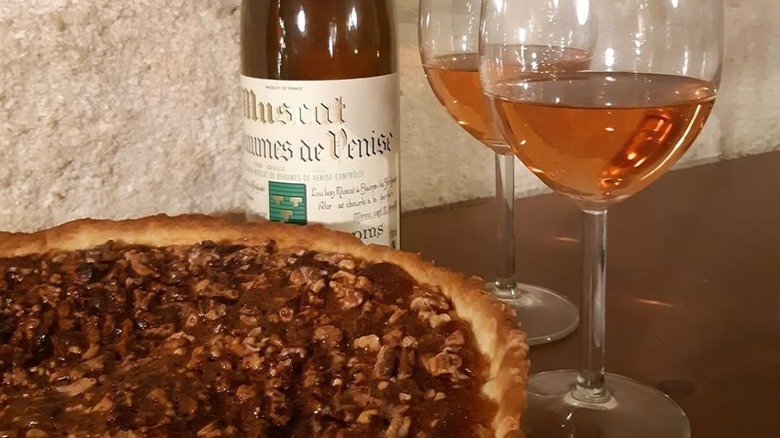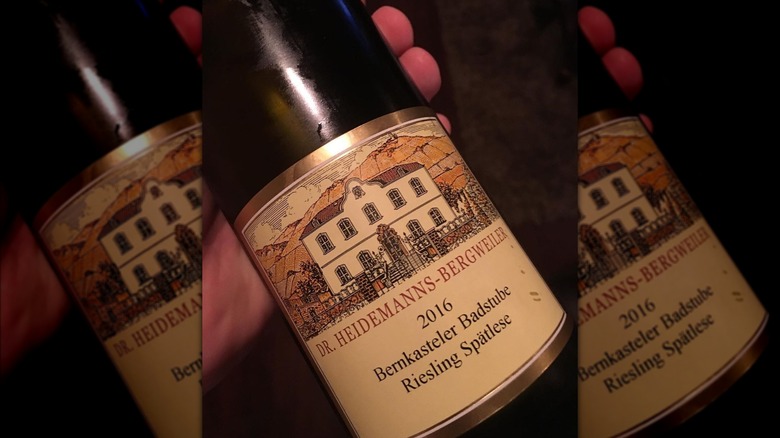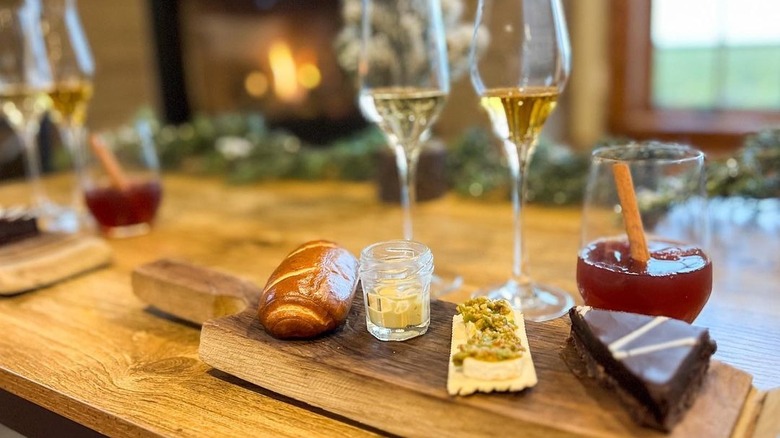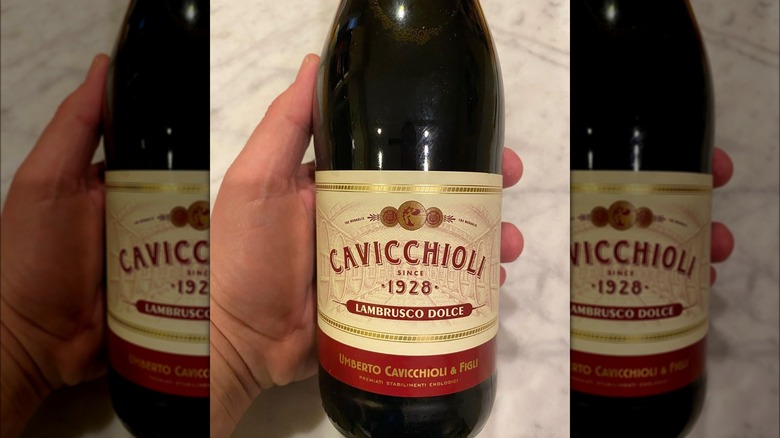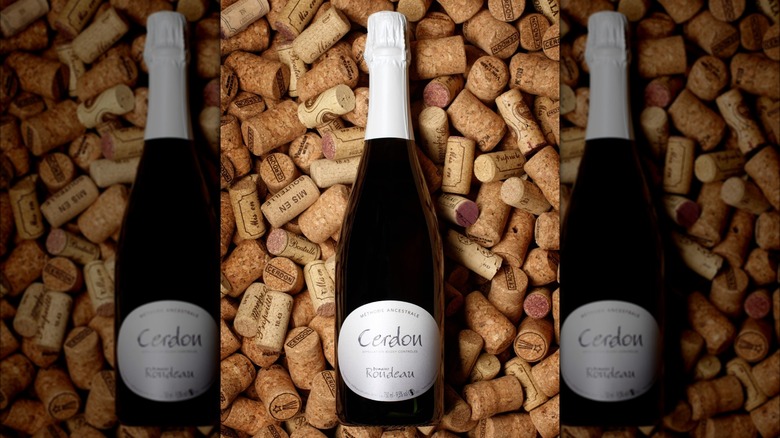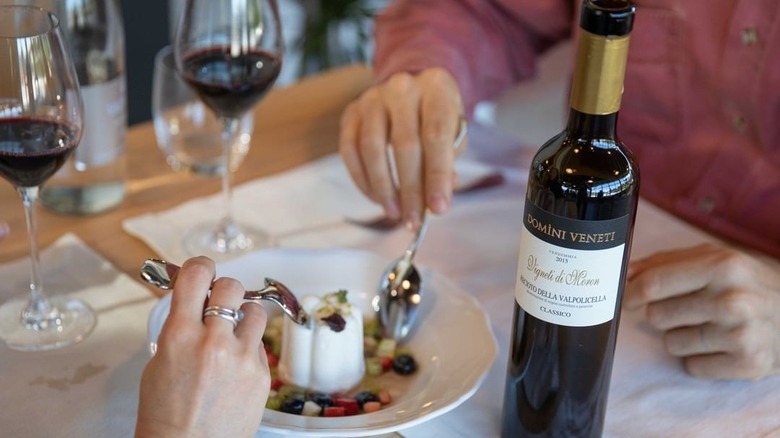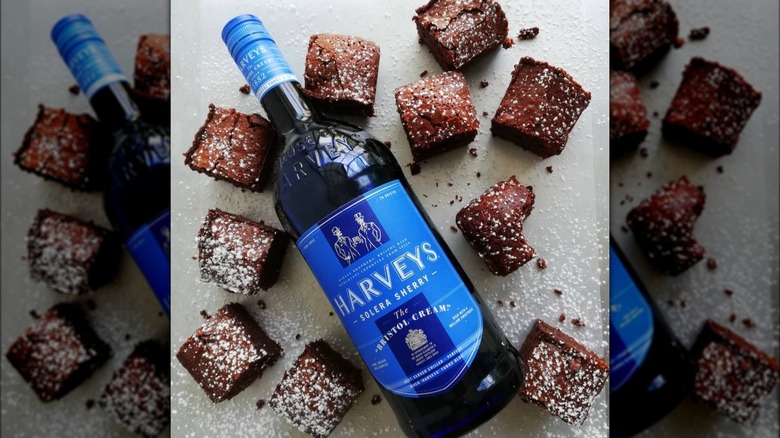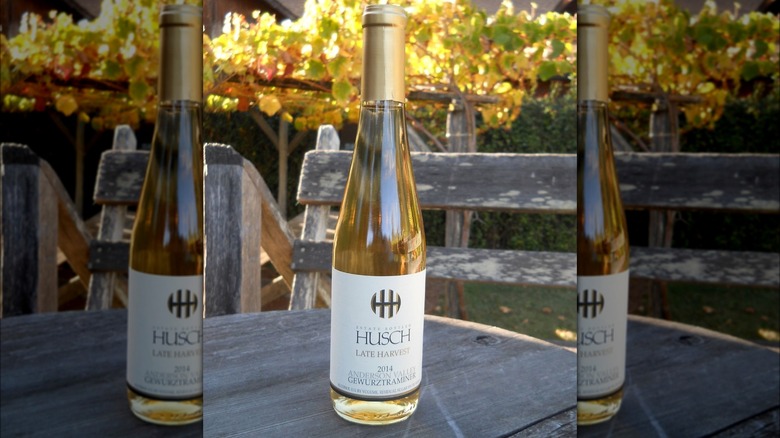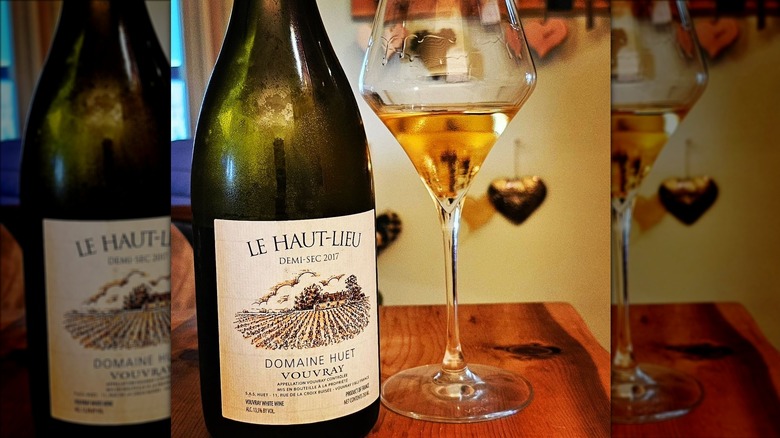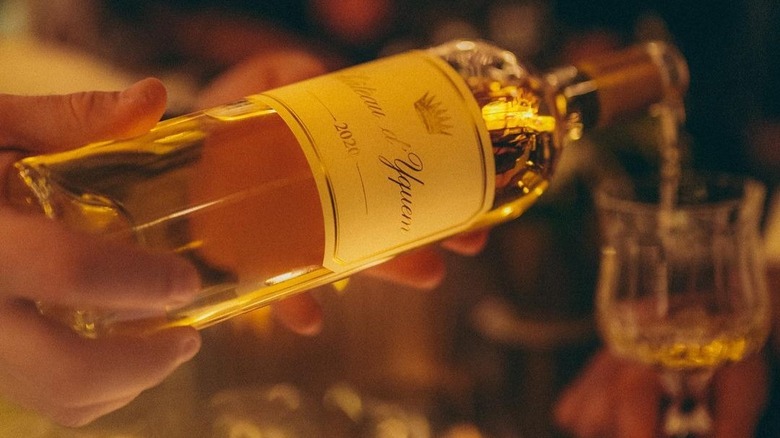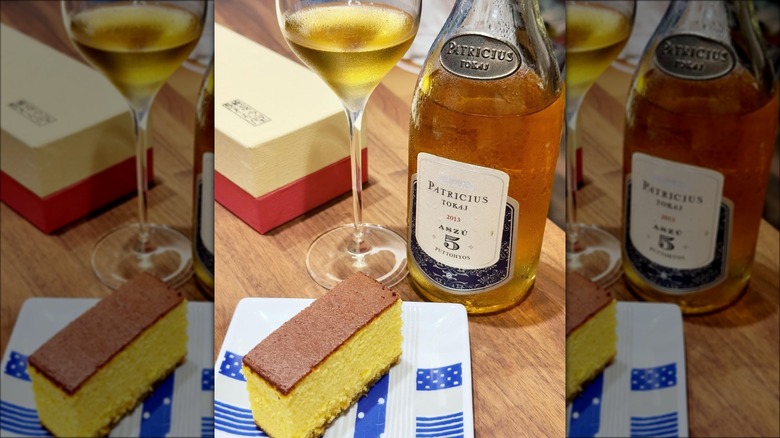Sommelier Recommends The 14 Best Beginner Wines
If you're just beginning to explore classic wines, it's easy to become overwhelmed by the variety on the market. Thankfully, there are several ways to categorize wine to simplify its complexities — like whether it's a dessert wine or table wine. According to the U.S. Alcohol Tobacco Tax and Trade Bureau, table wines have an alcohol by volume (ABV) of 7% to 14%, while dessert wines are between 14% and 24% (though some products informally considered dessert wines may have a lower ABV, and various table wines are higher in alcohol). More importantly, dessert wines have more residual sugar, resulting in a perceptibly sweeter taste.
Those unfamiliar with sweet dessert wines might be inclined to skip over them in favor of bold dry varieties — but they'd be missing out. Dessert wines are made with both red and white grape varieties and various vinification methods, offering a spectrum of flavors and styles. Some are fortified, while others are produced from fruit that hangs on the vines long past the usual harvest date. Many dessert wines are delicious when sipped solo or paired with certain desserts, cheeses, and fruits.
To help guide anyone slowly working their way through the world of wine, I spoke with Natalie MacLean, editor of North America's largest wine and food pairing site. Between her recommendations and my own expertise as a Certified Specialist of Wine, here are the best dessert wines to taste if you're a beginner to the style.
Port
Port wine is a classic fortified wine that comes in various styles depending on the aging regimen. Made with a blend of grape varieties — primarily red, though white port is also produced — the result is a rich and bold taste that makes an excellent conclusion to a meal. It's made by fortifying a base wine with brandy, amplifying the alcohol and sugar content, as well as the wine's body.
If you're curious about this dessert wine and want to begin your exploration, ruby port is a great option. It's made in a fresher and fruitier style that's heavy on red and dark berry notes and pairs well with chocolate desserts. As Natalie MacLean explained, "The alcohol cuts through the mouth-coating richness of the dessert, helping to spread it luxuriously in your mouth." She also recommends trying tawny port, which is aged in oak for a smooth and nutty taste that's reminiscent of toffee and vanilla.
Once you fall for the tantalizing aromas of port, you might eventually want to shell out for vintage port, which is aged in the bottle for several years or decades. MacLean's favorite port producers are among the top in the business, such as Graham, Taylor Fladgate, Dows, Fonseca, and Quinta do Noval; they produce all of these styles.
Moscato d'Asti
You don't have to go for high-alcohol options every time you drink dessert wine. Many sweet wines have a lower alcohol content, making them perfect for the end of a meal when you may have already imbibed in a couple of glasses. Although moscato d'Asti is different from other wines, it's easy to love for beginners and aficionados alike thanks to its fragrant aromas and balanced acidity. Produced with the moscato grape in the region of Asti in Italy, these wines showcase notes of stone fruit, orange blossoms, and honeysuckle.
Moscato d'Asti is a treat sipped without food, but it's also great paired with creamy desserts, fruit, and simple sponge cakes. The alcohol level is low — averaging around 5.5% ABV — and offers a sweet complement to your palate without weighing it down with too much booziness. The wines are lightly sparkling, adding to their sensory appeal and taming the perceived sweetness. You'll find options for every budget, but sticking to quality producers will guarantee a better balance of acidity and flavors. I recommend a bottle of Moscato d'Asti DOCG by Vietti, or Braida's Vigna Senza Nome Moscato d'Asti DOCG for another dazzling take.
Brachetto d'Acqui
Sweet and sparkling red wine is a fun twist on the usual, and brachetto d'Acqui is a reliable rendition that's sure to please beginner dessert wine drinkers. Made with the brachetto grape from Acqui in the region of Piedmont, Italy, this ruby red wine is a delicious addition to any dessert menu.
The light sparkle brings a pleasant mouthfeel to complement the sweetness, while candied strawberry notes mingle with orange zest, black currant, apricot, and cream. Subtle spices and a balanced acidity round out the palate, adding complexity to this playful wine. Thanks to the luscious red fruit aromas, brachetto d'Acqui is a natural match with red berry desserts, while the creamy undertone is a seamless pairing for chocolate-centric dishes. Serve it with ganache, molten lava cake, or even just a few squares of chocolate.
A bottle of brachetto d'Acqui by Viticoltori Acquesi – which was highly rated by Natalie MacLean — is brimming with hints of red and black berries. Alternatively, I suggest trying Braida's version, which displays delicate notes of rose lingering in every sip.
Muscat de Beaumes de Venise
Though muscat differs from muscadet wine, it's a natural choice when making dessert wines thanks to its richly perfumed aromas and honeyed characteristics. In Southern France, muscat de Beaumes de Venise is the local vin doux natural: a style of dessert wine made by adding a neutral spirit to fortify, which simultaneously stops the fermentation to retain its sweetness. The result is lusciously fragrant with intense notes of stone fruit, mango, lychees, honey, and flowers. Although it's decidedly sweet, the wine has just the right amount of acidity to bring freshness to each sip.
Savor this delectable wine with a cheese course to contrast the bold aromas, or serve it with dessert to complement the natural sweetness. A light and airy meringue makes a tasty match, as does a fruit or nut tart. Try a bottle of muscat de Beaumes de Venise by Famille Perrin, a reputable producer in the area. Domaine des Bernardins makes another stellar version that boasts notes of rose and apricot on the palate. Serve this dessert wine chilled for a refreshing accompaniment to finish off your meal.
Spätlese riesling
Riesling might be among the first grape varieties many people mention when they think of sweet wines, but it actually ranges from searingly acidic and dry to decadently sweet. For the latter, there's a spectrum of styles, too, including late harvest and dried grapes, as well as icewines. Spätlese (AKA late harvest) is an enjoyable choice as an introduction to the world of sweet rieslings.
Although this style features plenty of residual sugar, riesling's natural acidity brings it all into balance. You'll be left with a rich, full-bodied wine with notes of stone fruit, mango, lime, white flowers, and a mineral undercurrent. Try a bottle of Bernkasteler Badstube Riesling Spätlese by Dr. Heidemanns-Bergweiler for a ripe and juicy taste of this timeless style. The low alcohol content makes it a balanced option to pair with a final cheese course, contrasting the creamy richness with its sweet and tangy quality. Additionally, be sure to skip bottles labeled as "trocken," as they will be dry and not as pleasant if you're serving them with dessert.
Icewine
Canadian wine doesn't get a lot of international visibility, but when it comes to icewine? The country's frigid winter temperatures make it a reliable source. Produced with grapes frozen on the vine and harvested late in the season, this dessert wine is certainly unique. Thanks to the longer ripening time, the frozen grapes develop more complex and honeyed flavors, adding layers of nuance to the final product. While this dessert wine can be made with a variety of grapes, riesling and vidal are common contenders in Canada.
Natalie MacLean loves pairing icewine with desserts. "They have a zingy acidity and luscious texture to marry beautifully with these dishes," she noted, before mentioning Marynissen, Tawse, Reif, Pillitteri, and Konzelmann are among her favorite Canadian icewine producers.
Furthermore, given the labor-intensive harvesting and vinification process doesn't result in huge volumes, MacLean pointed out that most icewines are sold as half bottles. Thankfully, you only need a small pour of these intensely flavored wines, and should serve them chilled to highlight the acid balance.
Lambrusco dolce
Sparkling red lambrusco wine comes in a range of styles, from sweet to dry. While the latter pairs delightfully with a platter of charcuterie, the former is more suited for desserts. Made with several regional grapes from the Italian province of Emilia-Romagna, this sparkler is sure to win you over. The wine's flavor profile varies depending on the dominant grape varieties, but expect dark fruits on the palate like cherry and blackberry. You'll also notice hints of rhubarb and violet, along with a creaminess to round it out.
This delicately sparkling wine can be served with hard salty cheeses (or soft, creamy ones for contrast), as well as dried fruits and nuts to complement. Alternatively, you can highlight the wine's fruitiness by pairing it with berry or stone fruit desserts — though some chocolate wouldn't hurt, either. To taste this Emilia-Romagna delicacy, I recommend picking up a bottle of Cavicchioli 1928 Lambrusco Dolce. It's brimming with dark fruit aromas, a hint of herbs, and a floral finish.
Bugey Cerdon
Of all the varieties of rosé, there's something especially celebratory about sparkling rosé. This is particularly true when it's lusciously sweet, like with Bugey Cerdon. A category of wine from the alpine region of Jura, France, Bugey Cerdon is a dessert wine made with gamay and poulsard grapes. Both varieties are also used in the local red wines, though Bugey Cerdon's sweet and bubbly nature is decidedly one of a kind.
Raspberry and red fruits dominate the palate, which is rich in flavor yet light in body. Floral notes are complemented by a pleasant acidity, making this a delicious wine to sip on as an aperitif or with dessert. You can serve it with pastries sprinkled with powdered sugar, a bowl of strawberries and cream, or a slice of dark chocolate cake.
Add some fruitiness to a nut-based dessert or a cream pie with a glass of Bugey Cerdon, and let the delicate mousse wash it all down. My choice is Domaine Rondeau Cerdon de Bugey Demi-sec with a chill, as it's a reliable option that showcases the richness of this sparkling rosé wine.
Recioto della Valpolicella
Valpolicella in Italy is known for its pleasant food-friendly red wines and potent amarone, but it's also home to a stellar dessert wine. Recioto della Valpolicella is made with a laborious process that involves air-drying grapes for several weeks to concentrate the flavors and sugars. After this, the grapes are pressed, and the little juice collected is vinified into a sweet and intensely flavored wine. This is then aged in oak barrels and eventually bottled after several years.
Thanks to the winemaking process, recioto della Valpolicella features dark fruit, molasses, chocolate, and nuts on the palate, and offers a multidimensional experience for drinkers. A subtle tannin profile keeps this wine from being overly rich and adds an element of savoriness, as well. Pair the wine with crispy fried pastry, chocolatey desserts, or dark cherry treats to bring out its layered flavors. If you're searching for a quality bottle, Domìni Veneti Recioto della Valpolicella DOCG offers a classic expression of this iconic wine.
Cream sherry
Sherry comes in a multitude of styles to suit every palate. But if you're looking for a dessert wine to satisfy your sweet tooth, skip fino and opt for cream sherry. According to Natalie MacLean, "They're made by adding more brandy to boost both their alcohol and sugar levels." This process amplifies the overall complexity while sweetening the wine at the same time.
Nutty notes mingle with caramel and nougat in this sherry variety, imbuing every sip with a velvety allure. "Alcohol gives the impression of richness and sweetness," MacLean explained, and she's a fan of serving fortified wines such as cream sherry with richer desserts. You can try cream sherry alongside a scoop of simple vanilla ice cream or a puff pastry. If you're wondering what brand to consider when reaching for a bottle, an obvious choice would be Harveys Bristol Cream, which is a true pioneer of this dessert wine style.
Late harvest gewürztraminer
Late harvest wines are made with grapes that hang on the vines later into the season, resulting in higher sugar levels and more concentrated flavors. As the grapes stay on the vine, they sometimes become affected by a (friendly) fungus called botrytis, which soaks up the water from the fruit. This leaves behind grapes that look shriveled and undesirable yet are notably concentrated in sugar and aromas.
The gewürztraminer variety of late harvest dessert wines gets its name from the German word for seasoning and spice – hinting at what you can expect when you take a sip. Compounding the grape with a later harvest further amplifies the aromas and makes this an excellent contender to serve with dessert. Expect honeyed notes with hints of tropical fruit, peach, ginger, clove, and rose petals; the best examples are off-dry with an element of acidity.
Additionally, when pairing this wine, Natalie MacLean suggests considering "desserts with just a touch of sweetness and some balancing acidity, such as fruit-based pear tarts, apricot cobbler, and baked apples." Try a half bottle of Late Harvest Gewürztraminer by Husch Vineyards to savor the tantalizing concoction.
Sweet chenin blanc
Chenin blanc has chameleon-like qualities, showing up as everything from searingly dry to sweet and sparkling. Chenin blanc boasts a rich fullness as well as notes of tropical fruit and stonefruit, honey, and candied citrus peel. If botrytis is present, the grapes will be even more flavorful and worthy of transforming into a dessert wine.
Natalie MacLean enjoys pairing late harvest chenin blanc with desserts that complement the wine's sweet and acidic qualities, such as fruit-based desserts. Additionally, combining sweet chenin blanc with a slice of creamy cheesecake or a golden crème brûlée creates a decadent match, while the wine's sweetness plays well with a cheese plate.
As for sweet chenin blanc varieties to consider, Herzog Late Harvest Chenin Blanc is an aromatic sipper layered with complexity to satisfy you as you round off your meal. Meanwhile, you can't go wrong with a bottle of demi-sec or moelleux by Domaine Huet, a top producer in Vouvray, France.
Sauternes
If the concept of good-for-your-wine fungus piqued your interest, sauternes is a must-try. From Bordeaux, France, the wine is made with sémillon, sauvignon blanc, and muscadelle grapes that have been botrytized. The result is decidedly luscious and brimming with honeyed aromas, tropical fruit, ginger, caramel, marmalade, and spices. Acidity comes into play, too, ensuring sauternes isn't cloyingly sweet.
Now, seeing how the action of botrytis shrivels grapes, producing wine in large volumes is difficult with these styles. Consequently, sauternes is usually sold in half bottles — though this is fair since the concentrated taste makes it much more of a light sipper. More than that, the smaller sizes are a good thing, as it's a pretty pricey dessert wine. To taste an icon of the style, a bottle of Château d'Yquem is a must (if you're willing and able to pay). Pair it with an almond or lemon tart, cheesecake, or meringue. You can also try pouring a glass to serve with a pungent cheese such as Roquefort.
Tokaji Aszú
For another version of botrytized wine, look no further than Hungary. Tokaji Aszú is the nation's star dessert wine and is made with a blend of local white grapes affected by botrytis. Citrus, apricot, marzipan, ginger, honey, and floral notes play together in the final product, which is heightened by a delicious sweetness that coats the palate. There's plenty of acidity to counter the unctuousness, though, providing a refreshing quality that downplays the intensity.
Natalie MacLean suggests serving this dessert wine with fruit tarts or baked apples, or any other option where "the muted sweetness of the dessert doesn't overwhelm the wine." Creme caramel is another popular match, or you can contrast the sweetness with a few chunks of sharp cheese. There are plenty of options out there to try this Hungarian dessert wine, but I'd recommend sampling this golden elixir with a bottle of Tokaji 5 Puttonyos Aszú by Patricius.
